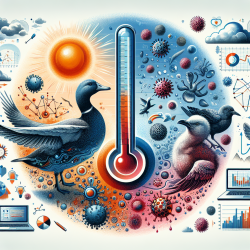As practitioners dedicated to creating great outcomes for children, it's crucial to stay informed about the latest research and its practical applications. One study that caught our attention is "Evaluating the Impact of Environmental Temperature on Global Highly Pathogenic Avian Influenza (HPAI) H5N1 Outbreaks in Domestic Poultry," which provides significant insights into how environmental factors, particularly temperature, influence disease outbreaks. This research is a goldmine for data-driven decision-making and offers actionable insights for practitioners.
The Role of Environmental Temperature
The study highlights that higher environmental temperatures significantly impact the timing and occurrence of HPAI H5N1 outbreaks in domestic poultry. Specifically, temperatures around 25°C were found to be a critical risk factor for earlier outbreaks. This relationship was consistent across different epidemic waves, although the magnitude of the impact varied.
Key Findings:
- Higher temperatures correlate with earlier outbreak dates.
- The impact of temperature increased over successive epidemic waves.
- Temperature was negatively related to outbreak dates for most epidemic waves, except for one where higher temperatures delayed outbreaks.
Implications for Practitioners
Understanding the role of environmental temperature in disease outbreaks can help practitioners develop more effective prevention and intervention strategies. Here are some ways to apply these findings:
1. Enhanced Surveillance
Implement temperature-based surveillance systems to predict and monitor potential outbreaks. This proactive approach allows for timely interventions, reducing the risk of widespread infections.
2. Data-Driven Decision Making
Use temperature data to inform decisions on resource allocation, such as where to focus vaccination efforts or deploy additional healthcare resources. Data-driven strategies can significantly improve the effectiveness of interventions.
3. Further Research
The study opens avenues for further research. Practitioners can collaborate with researchers to explore other environmental factors that may influence disease outbreaks. Understanding these relationships can lead to more comprehensive disease prevention strategies.
Conclusion
The research on environmental temperature and HPAI H5N1 outbreaks offers valuable insights for practitioners. By integrating these findings into practice, we can enhance our ability to prevent and control disease outbreaks, ultimately creating better outcomes for the communities we serve.
To read the original research paper, please follow this link: Evaluating the Impact of Environmental Temperature on Global Highly Pathogenic Avian Influenza (HPAI) H5N1 Outbreaks in Domestic Poultry.










